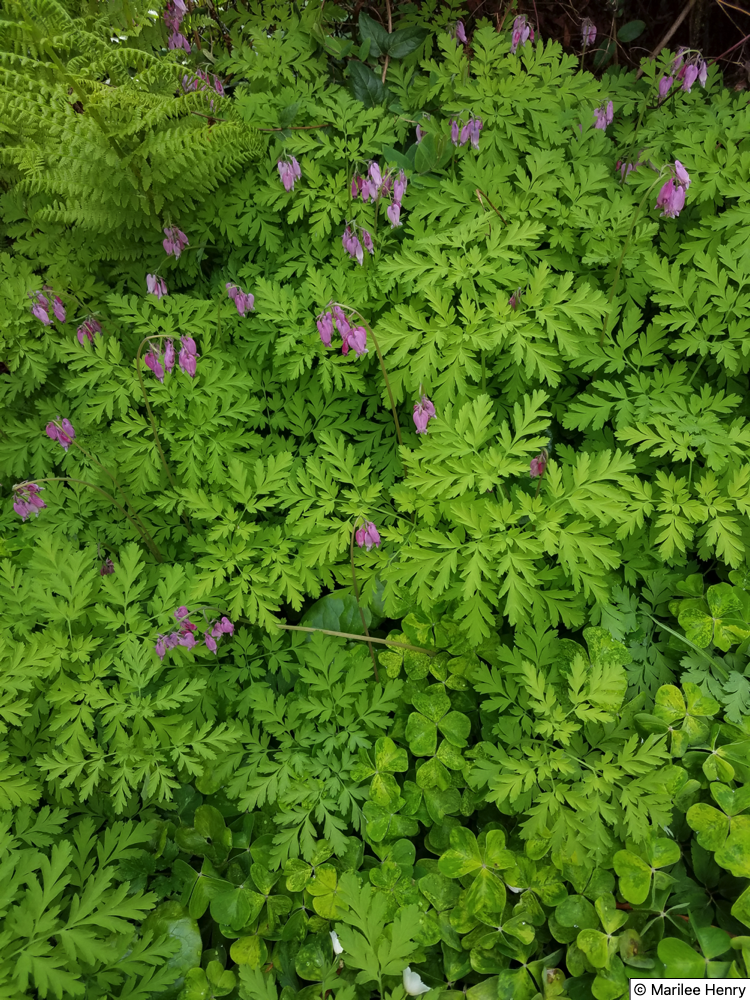
by Marilee Henry

On a spring walk through our moist woodlands one is likely to spy swatches of lacy blue-green leaves spread among the understory in the dappled sunlight, with clusters of pink heart-shaped flowers drooping on succulent leafless stalks rising above the fern-like leaves. Easily recognized and a favorite native in western Washington, Pacific bleedingheart can be found forming lush carpets in forests and urban gardens alike.
This native grows chiefly in moist woods west of the Cascade crest at low to mid-level elevations in the mountains, with pockets also occurring in the Columbia Gorge and in the southeastern corner of Washington state. Our species in Washington is technically Dicentra formosa ssp. formosa.
Pacific bleedingheart's familiar blossoms, about 1 inch in length, are composed of four petals, the outer 2 heart-shaped petals covering two inner ones, connected at the tip where the outer petals flare. Two slender pointed sepals are attached to the outer petals at their base.
The flowers vary in color from pale to deep pink, and are occasionally white, forming clusters of 5 to 15 blooms nodding atop 12 to 18 inch long fleshy hairless stalks. The bloom period may begin as early as March and last through June. Deeply cut fern-like leaves are usually 3- sometimes 4-times divided and are also hairless. Both flower and leaf stems are unbranched, arising from the plant's brittle rhizome. Fruit capsules, looking like miniature pea pods up to 2 inches in length, set in the fall and contain numerous small black seeds.
Each seed has a small attached appendage called an "elaiosome" which is a nutrient-filled sac intended to attract ants. The ants carry the seeds back to their nests where the elaiosomes are consumed by their larvae and/or the adults. The undamaged seeds are then removed to the nest's garbage area or "midden" where they are likely to germinate in the midden's rich humus. Dispersal of seeds by ants is called "myrmecochory". It can be a mutually beneficial behavior whereby the ants procure highly nutritious food for their young in exchange for seeds being protected from predation by other animals while being transported to rich soil pockets away from parent populations. A number of other woodland species depend on myrmecochory, including trillium, violas, and wild ginger. Here is a picture of an ant dragging a trillium seed by its elaiosome.
Pacific bleedingheart is an important source of spring nectar and/or pollen for hummingbirds, bumblebees, bees, syrphid flies, butterflies, and other pollinators. It is a host plant for the larva of Parnassius clodius butterflies. Amphibians, arthropods, reptiles, birds, and other small animals shelter in its thick leafy cover.
Indigenous people chewed the roots of Pacific bleeding-heart for toothache, made an infusion used as a wash to promote hair growth, and fashioned a decoction from crushed roots for deworming. However, it is not recommended that you try these remedies! Warning: this plant contains toxic alkaloids that can cause poisoning if ingested in large quantities, which can be fatal to cattle and horses. Do not plant it in your pasture!
Pacific bleedingheart's vegetation can be mistaken for that of a very invasive weed called herb Robert, or stinky Bob (Geranium robertianum). Especially when not in bloom, well-intentioned but unknowing gardeners may unfortunately "weed out" the native. But the differences are obvious once pointed out. Bleedingheart has heart-shaped drooping flowers, hairless non-branched non-jointed leaf stems, has no foul odor when crushed, has roots that are brittle rhizomes, and produces light green smooth peapod-like seed capsules, whereas herb Robert has 5-petaled symmetric blooms ~ ½ inch across, has hairy, jointed stems that get a reddish tinge in fall or bright light conditions, has a foul odor when crushed (hence the "stink" in "stinky Bob"), has fibrous shallow roots, and produces seeds in brown teardrop-shaped capsules with a "crane's beak" protrusion.
Native Pacific bleedingheart is a must-have for urban woodland areas, but is also terrific in flower borders, as a groundcover between shrubs, or even in rock gardens not located in hot sun. It prefers partial shade and moist (but not soggy!) rich soils. Plants may go dormant during drought, but supplemental consistent watering during the dry season can encourage rebloom in the fall. Great companion understory plants include Pacific waterleaf, trillium, false Solomon's seal, wild ginger, red huckleberry, evergreen huckleberry, salal, western sword fern, and ladyfern.
Pacific bleedingheart will easily reseed itself (with help from the ants!) but can also spread by rhizomes in non-compacted soils. Seeds can be collected in late summer or early fall when pods are plump and well-formed. They should be planted as soon as possible in rich potting soil, as their viability declines upon drying out. Roots may also be propagated by division: carefully dig up the root ball in early spring or late fall, hydrate it for a few days, cut root ball into sections with each containing one or more new buds, and replant all in moist rich soil.
Remember, "You are nature's best hope!" - Doug Tallamy, author of "Nature's Best Hope" and "Bringing Nature Home".
Marilee Henry
Kirkland Community Wildlife Habitat Team Member, Washington Native Plant Society (WNPS) Native Plant Steward, Green Kirkland Steward, Finn Hill Neighborhood Alliance Contributor
Snohomish Conservation District
Evergreen State Fairgrounds, Monroe, March 1-2, 2025
Limited walk-up sales.
Bothell Library Seed and Plant Swap
March 29, 2025, 1:00pm - 3:00pm
Oxbow Farm and Conservation Center Native Plant Sale
April 5, 2025, 10am - 4pm
WNPS Native Plant Sale
April 26, 2025, Bellevue Botanical Garden